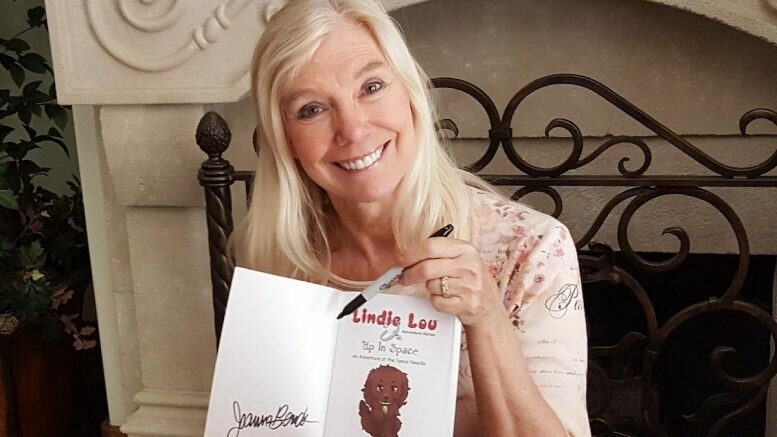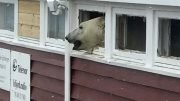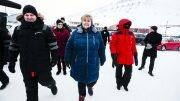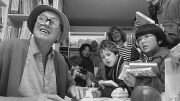Author of the kid’s “Lindie Lou Adventure Series”, Jeanne Bender, decided to set one of her beloved books on Svalbard – out of awe at the striking Arctic island. After reading “On Ice,” don’t be surprised if you’re filled with some Svalbard wanderlust yourself!
Jeanne Bender is an American author with a particular love for the Nordics. Following a trip to the Arctic – including Norway – she decided she had to write about the region. And so chapter book On Ice, part of the Lindie Lou Adventure Series, was born.
While conducting research for the book, Bender got to meet a number of wonderful people and have some extra-interesting Arctic experiences. She told Norway Today all about her captivating journey creating On Ice.
Read on for fascinating stories of local community and wildlife, and experience Svalbard through an author’s eyes, with this interview featuring Jeanne Bender.
What inspired you to write On Ice?
Each one of the Lindie Lou Adventure Series books takes place in a different location and in a different month of the year, beginning in August. Book 5, On Ice, Exploring the Arctic with a Polar Bear Cub, is my December book.
After traveling to the Antarctic and then the Arctic including Norway, Iceland, Greenland, and the Labrador Sea, I fell in love with the region. I visited the west coast of Norway during the midnight sun on a cruise ship.
Norway’s colorful port towns were absolutely charming. I was mesmerized by the beauty of the Gieringerfiord and spellbound by the powerful force of the Geiringer Falls. I met a sweet gentleman and his reindeer above the arctic circle and traveled all the way up to North Cape.
This was the closest I’ve ever been to the top of the world.
After my visit to North Cape, I searched the internet for places polar bears live and was pleasantly surprised that Svalbard had the largest concentration of polar bears in the world. When I realized Svalbard was above the Arctic Circle, I knew I wanted to write about this place.
My editors questioned my decision because most of my readers have not heard of Svalbard. I told them, “this is exactly my reason for choosing Svalbard. Because I would like to take my readers to places they may have never been to or heard of. To tell my readers about this amazing place where people live, animals thrive, and natural occurrences like northern lights exist.”
I was convinced beyond a doubt that my story would take place in Svalbard, Norway.
Since the book was published, I’ve found out that many of my readers tell me this is their favorite of all the Lindie Lou books, and some have put Svalbard on their bucket list for places they’d like to visit.
What part of the Arctic is most inspiring to you?
Traveling on a cruise ship along the west coast of Greenland, we sailed 300 kilometers above the Arctic Circle to Ilulissat, where glaciers reached sea level and where icebergs are created. We watched giant ice forms float out to sea while whales danced and breached nearby. The colors of these giant bergs were the most beautiful I’ve ever seen and to this day turquoise is one of my favorite colors.
At midnight we rushed on deck to experience a magnificent phenomenon known as the Northern Lights. I watched these lights in the sky create eerie patterns. They would disappear and reappear in different locations, teasing our eyes, challenging us to follow their journey, and then try to figure out where they went only to find another streak of light forming behind us (On Ice, Chapter 12).
The colors were very soft. I would describe them as light grey, light green, and soft purple hues. But when I looked through the lens of my friend’s camera, the Northern Lights came to life. They were much more colorful, almost effervescent. The green and purple colors were as bright as fireworks. They lit up the sky.
I watched the lights for a very long time, and for many nights I went up on deck to see them move and stretch across the sky in their mysterious way and I knew I had to tell the world about them.
Illustrator Kate Willows drew many images of the Northern Lights for the book On Ice. She did a wonderful job creating different patterns and textures, showing the Northern Lights in all their beauty. There are several color pictures throughout the On Ice book.
While visiting Iceland, I was offered two tours. To hike on top of a glacier and to explore an ice cave under a volcano. Honestly, I was a bit afraid of both when I read the details about these two adventures, but I challenged myself and signed up for both of them. What I experienced, was beyond my expectations.
I strapped metal cleats to the bottom of my boots, was handed a walking stick, and followed our tour guide toward a glacier. The first time I stepped onto its surface, I was very careful not to slip, I tested my cleats and found them to be reliable. Soon I was enjoying the thrill of being able to walk across this giant mountain of ice. At any given time, I could have fallen into a deep crevasse or walked off of the edge of the glacier. I carefully took one step at a time. After a while hiking on this glacier, I was glad I experienced this moment.
Later I thought about how this glacier completely covered the area, took over the land, and created a life of its own.
I was anxious to write about glaciers and explain how they move across the land. This is one of the first things I mention in my book, On Ice (Chapter 2).
Climbing into an ice cave under a volcano was a completely surreal experience. The cave was carved by melting water. It formed tunnels and passageways underneath the earth. I was given a harness to buckle around my torso and a helmet to protect my head from lowforming icicles. Our guide carried an ice pick in the event the ice shifted while we were in the cave and we had to dig our way out. He told us the volcano was active but the chance of it erupting was not likely. This made me feel a bit uneasy knowing I was actually walking in a cave under a volcano!
There were lights strung along the trail. As we traveled deeper into the cave I marveled at the colors. The cave walls were white, turquoise, gray, and black. Our guide mentioned how ice caves can change daily, depending on the weather. Warmer days produce waterfalls which can create and sometimes destroy ice cave tunnels.
We came across a room where a frozen waterfall formed one of the walls. It was so amazingly beautiful I knew I had to write about it. Water froze in time. Now, this was truly an amazing sight (Chapter 13).
We continued to travel through the ice cave, each turn revealing another unexpected sight. We saw icicles the size of people, rooms the size of a hotel lobby, even a tunnel that I imagined could become a really cool ice slide (Chapter 13 & 21).
Climbing out of the ice cave was another adventure. I required help. Our guide lifted me out of the cave by the harness strapped around my torso. After this amazing tour, our guide praised me for my bravery and handed me his ice pick for a photo op.
Who is this book intended for?
The Lindie Lou Adventure Series books are written for both boys and girls at a 3rd-grade reading level. However, I have grandparents and parents tell me they love my books.
They are actually beginning travel books, have a wealth of information about the locations I write about, and teach life lessons through a curious puppy named Lindie Lou.
One parent told me that after they read one of my books with her children, they made notes and are planning a “Lindie Lou tour” of Seattle (Book 2, Up In Space)
I encourage everyone to buy the Lindie Lou Adventure Series books for their families. I tell everyone to start reading them out loud to their younger children, as early as four or five years old, to point out some of the fun fonts we’ve added to each book, and show them the color pictures. These books are intended to transition children from reading picture books to beginning chapter books and eventually they begin reading the Lindie Lou books on their own.
Some children have written book reviews about my books.
Librarians and teachers tell me they have Lindie Lou Challenges in their classrooms, encouraging children to read the books. Then, they have the opportunity to meet the author in a
video session.
The Lindie Lou books make wonderful gifts, especially for children learning to read their first chapter books. They make great stocking stuffers and birthday gifts. The website offers free downloadable coloring pages and educational tools as well.
Please share a few stories about Svalbard residents that particularly stuck with you while you were researching the book.
With COVID-19 hindering my travel plans, the real challenge came with researching and connecting with locals in Svalbard to ensure I depicted an authentic Svalbard experience. I read dozens of articles and watched countless videos to familiarize myself with life on Svalbard. I studied everything from the weather patterns to rockets, from polar bear habitats to the geography and lifestyle of the community.
I also found a plethora of helpful, kind, and generous locals to help me write On Ice. Because English is not the primary language in Svalbard, I was very touched by the people we met and the help they provided.
Kristin Sunde of Visit Svalbard, kindly forwarded information about our On Ice book to Audun Bardseth from Svalbardposten.
Audun Bardseth from Svalbardposten wrote a wonderful article about us.
Visit Svalbard hosts a local article titled Tips from a local. This is where we met Lisa Djønne, a school teacher who happily introduced us to Stine Tvedt Kvam, a school teacher of nine-year-old students who were more than willing to answer our questions. Here are the highlights:
- The kids thought it was so exciting that an author in the US would write a book about Svalbard and Longyearbyen.
- They think this it’s a very safe place to grow up. There is not much to be afraid of. It’s a small community with no crime.
- The students describe Longyearbyen as a place where “we play a lot outside.” We have a long winter and they love skiing, driving snowmobiles, and traveling to their cabins outside the city. A lot of the
children also have mini-snowmobiles they drive by themselves. - I almost never hear them complain about cold weather even when it’s heavy wind and many minus degrees.
- Because of the small town they can walk everywhere so you see a lot of kids hanging around on the different playgrounds or in the middle of sentrum on our “skate ramp” even though I have never seen
somebody using a skateboard there. - Longyearbyen has a rich offer of leisure activities. Almost every day, the kids are busy with football, handball, gymnastics, choir, climbing, swimming, dog sledding, chess, or shooting.
- A lot of the kids also play different instruments.
- Students also like hanging out at the library or go to the movie theater on Sundays.
- I asked my students if they were worried about polar bears. The answer was no. Polar bears and weapons are part of everyday life, whether it is on a cabin trip, a mountain trip, or a school trip. In the dark season, we have our own polar bear guards in the schoolyard. This is part of their everyday life.
- All the students say that it is very good to be a child in Longyearbyen. It is best to be outside and when the sun comes back.
- The worst thing about being a child in Longyearbyen is when your friends move. A large part of the population who lives here are temporary.
Noora Partamies, a researcher from the Kjell Henriksen Observatory (KHO), was kind enough to contact us. She enthusiastically encouraged us to include the KHO in our book.
Locals from the Coal Miners’ Cabin were also happy to hear we were including them in our book.
My editor, Nancy Kiefer, also interviewed Dr. Jeff Welker, UArctic Research Chair, and his wife Molly Welker, an environmental scientist who lived in Longyearbyen for almost a year. Through them, I gained insight into the geography of the area, the habits of Svalbard animals, and the beauties and dangers of experiencing polar nights. This supportive relationship provided an ongoing reference to ensure that the integrity of the science I wrote about throughout the book was realistic.
Nancy and I had a serious discussion with Jeff & Molly Welker about polar bear cubs. We wondered if a cub would actually roam around outside of their den, without their mom’s protection. We determined that a one-year-old cub would and was old enough to be on its own.
Our character, Nanook (which means polar bear), we decided would be a one-year-old cub (Chapter 10).
Molly Welker, being an environmental scientist also inspired me to create a character named Chloe who is an aurora research scientist in the book On Ice (Chapter 7).
Is the book more didactic or fun – or both?
The Lindie Lou books are disguised as a fun book but are actually a learning tool. I don’t think anyone who reads these books considers them anything other than a fun adventure book, with an engaging puppy, who learns life lessons along the way.
So, I guess my answer is “both.”
What was the best part about writing this book?
The best part(s) are…
The research. When I travel the globe, every now and then I come across a really special place and I decide I want to write about it. This is how I felt when I went to Norway, Iceland, Greenland, and traveled through the Labrador Sea. When I reached North Cape, knowing I have traveled above the Arctic Circle was a real thrill to me. I thought to myself, how many people get a chance to come to the Arctic? I MUST write about this amazing place!
When I write, the characters sometimes come to life all on their own. I especially liked writing about Pinni (a baby walrus – pinniped). She was a complete surprise to me. I loved how she simply appeared in my mind, I added her to the story and fell in love with her sweet helpless personality (Chapter 19).
When my editor, Nancy Kiefer and I see the illustrations for the very first time, it’s so exciting to us. Illustrator Kate Willows creates such adorable characters with so much expression we squeal when we see them. This is always an extremely fun part of writing the Lindie Lou books.
And finally, when I hold my book, in my hands for the first time. I am in awe at how beautiful they look, they’re colorful, they smell like fresh paper, and I can’t wait to read the actual book! I’ve read On Ice several times and just like the other books in the Lindie Lou Adventure Series, I never get tired of them.
What was the most challenging part about writing this book?
The most challenging part of writing a book is to;
- make sure my stories are realistic,
- my characters are believable,
- my facts are accurate and
- make sure my material is age-appropriate
- that I don’t scare or offend my readers.
I spend an incredible amount of time with my editor, technical editors, and proofreaders going over these important points until we are sure we are presenting a quality book we can all be proud of.
Where can our readers find the book?
The Lindie Lou Adventure Series books are available almost everywhere, in paperback, hardcover, and ebook format. It is available online here, Amazon, Barnes & Noble, Follett School Solutions, Ingram, Baker & Taylor, and many other fine retailers and distributors.
Do you have plans to travel to the Norwegian mainland and/or Svalbard in the future?
I have traveled to every place I’ve written about including Norway, but not Svalbard. After picking Svalbard as the location for my On Ice book, the COVID-19 pandemic prevented me from traveling outside of the US and Mexico. So, I went to the internet and spent hours and hours viewing local videos and Facebook pages. When I found the Coal Miners’ Cabin, I knew this would be the perfect place to have the characters in my book reside (Chapter 8, 9, 10, 11, 27, 28).
The Kjell Henriksen Observatory was also a very obvious choice (Chapter 7 14, 20). The Northern Lights can easily be seen from this remote location.
My editorial team and I eagerly await an opportunity to visit Svalbard and meet the people who have been so helpful in the process of writing On Ice. We are excited to see the impact On Ice has on children and educators.
“Providing curriculum support to teachers is extremely important to us. We are proud to have several educators as part of our team,” also explained Nancy Kiefer who leads Team Lindie Lou.
Will you write any similar books in the future?
Every one of the Lindie Lou Adventure Series books is very different because each book in the series place in a different location in and in a different month of the year. My next book titled New Years’ Eve Surprise will take place in Europe. We haven’t chosen a location yet.
I look forward to traveling the world, and writing about as much of what I see and learn as I can… Over the shoulders and through the eyes of little Lindie Lou.
Source: #NorwayTodayTravel
Do you have a news tip for Norway Today? We want to hear it. Get in touch at [email protected]





Hello Norway Today. Thank you for printing my story. I LOVE your country, the diversity, and your unique ecosystem. I hope my book… On Ice, Exploring the Arctic with a Polar Bear Cub… brings many curious visitors to Svalbard! I plan to visit as soon as possible!
Sincerely, Author Jeanne Bender